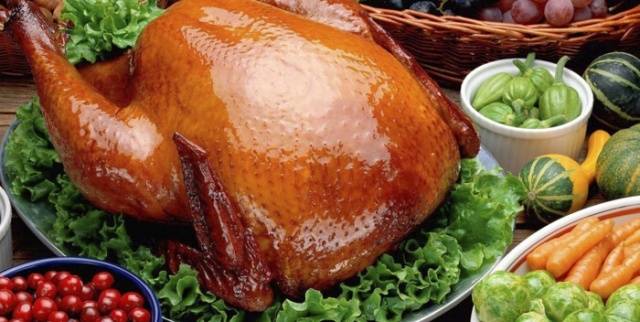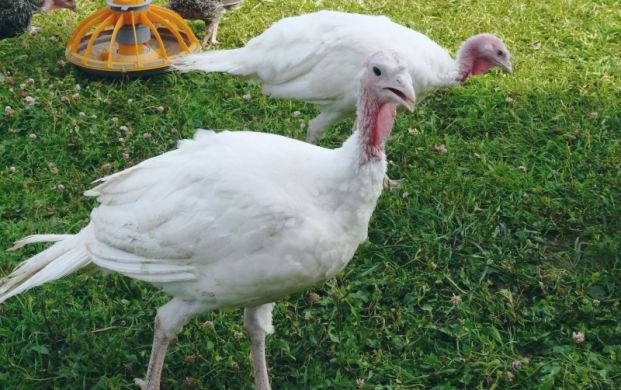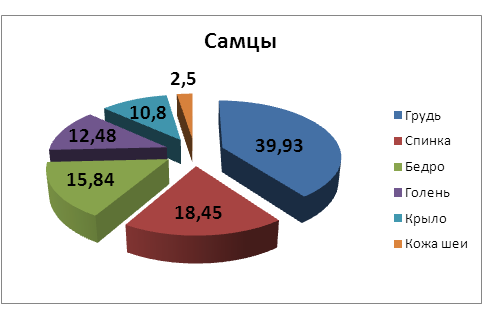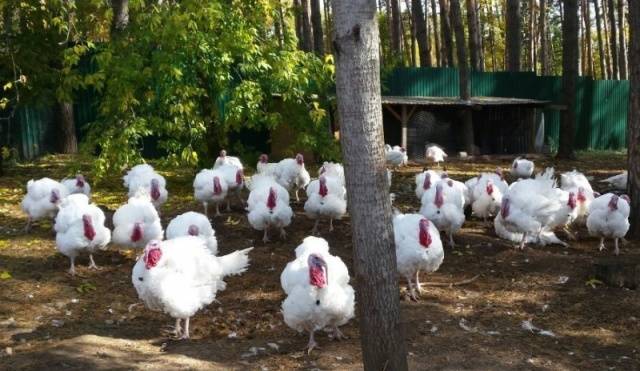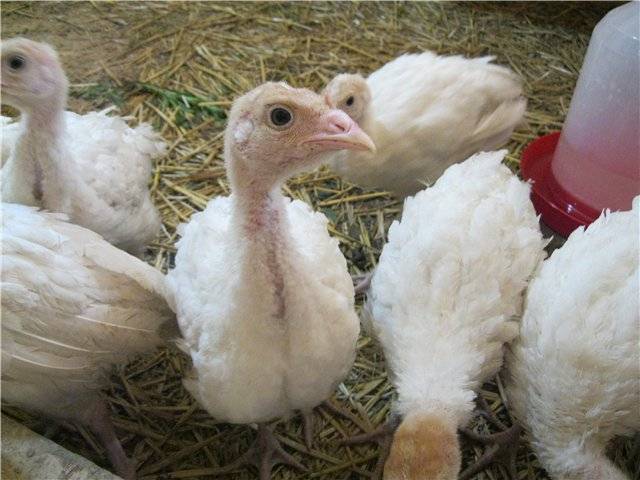Content
There is a worldwide data bank where information about the breeds of turkeys is recorded. Today their number is more than 30. In our country, 13 breeds are bred, of which 7 are bred directly in Russia. Turkey turkey is a cross obtained by Russian breeders of the North Caucasian Poultry Experimental Station. In the Russian Federation, only this institution is engaged in selection and breeding work with turkeys.
For breeding the Victoria cross turkeys, large males with well-developed pectoral muscles were chosen. They were distinguished by their rapid growth. Turkeys were selected with high egg production and early maturity. Cross was created on the basis of lines breeds white broad-breasted.
Study of the quality of meat and fat of cross Victoria turkeys
In 2014, specialists who bred Victoria turkeys conducted a study of the quality of meat and fat of the cross. For the study, we took 100 one day old turkey poults and raised them to the age of 140 days.
Samples of white (from the pectoralis minor muscle) and red (from the gastrocnemius muscle) meat from 5 turkeys and the same number of females were taken from the total mass.
The following meat parameters were tested in a laboratory:
- moisture contents;
- fat;
- protein;
- total nitrogen;
- muscle and connective tissue proteins;
- general toxicity.
The results of the study confirmed the high biological value of the muscle mass of the Victoria cross.
Studies of fat have shown that it contains a lot of unsaturated fatty acids, which means that the product is of high quality. This is confirmed by the low melting point of fat - 31.7 degrees. It has also been proven that the adipose tissue of the Victoria Cross turkeys is easily absorbed and well digested by humans. The product contains many polyunsaturated fatty acids, which means that the fat has excellent biological value.
Biotesting to identify the level of general toxicity showed the first permissible degree (index up to 0.20), which indicates the absence of toxic properties in the meat and fat of the cross. This product is environmentally friendly.
Characteristics of the cross Victoria
Cross Victoria was bred for breeding on a non-industrial scale: on small farms or at home.
The weight of turkeys at the time of "readiness" (for females - 20 weeks, for males - 22) reaches 13 kg, turkeys - 9 kg. Representatives of the Victoria cross have a compact body, well-developed muscles of the chest and legs.
You can watch the description of the cross in the video:
The turkey lays 4-5 eggs per week, which is about 85 eggs during the reproductive period. At the same time, 97% (that is, 82 eggs) will be fertilized - a very high rate. One egg weighs 87 grams.
The survival rate of turkey poults up to 16 weeks of age is also quite high: it is 94% of all hatched chicks, and the cause of the death of babies was more often injuries than diseases.
In addition to good early maturity, egg production, egg fertilization and survival of chicks, the turkeys of this cross have a high resistance to stress. They are hardy and unpretentious both in nutrition and in conditions. content... Of course, this does not mean that Victoria Cross turkeys can be grown outdoors with only one grain.
Adult turkeys can stay in a room that is not heated, and they feel good when walking, because.are resistant to external adverse influences and have good innate immunity that protects turkeys from infections.
The percentage of carcass parts in males and females can be seen in the photo:
The weight of meat of the carcass of turkeys of the cross Victoria at slaughter age is 5.6 kg, of turkeys - 3.7 kg.
In the reviews of breeders about the Victoria cross turkeys, the endurance of birds, their beauty and the taste of meat are especially highlighted.
Conditions of keeping turkeys cross Victoria
Although the turkeys of this cross are undemanding to the conditions of detention, you need to understand that the better the care, the greater the productivity of the birds will be in the end.
Victoria turkeys can live in a regular poultry house, without special conditions for the temperature regime (except for turkeys). The main thing is that it is dry, light enough and there are no drafts.
For bedding, hay or straw is often used, which must be replaced periodically.
For good health and prevention of obesity, walks are important for Victoria cross turkeys. The place for walking must be fenced off with a high fence and provided with a canopy from the rain.
To get the maximum number of eggs, turkeys need to provide a cozy nest. There should be no more than 5 Victoria turkeys per seat. A roof should be installed over the nest, preferably sloping so that birds cannot sit on it. In order for the female cross of Victoria to calmly lay or incubate eggs, the nest must be installed in such a place in the turkey poultry where it will be quiet and darkened.
So that turkeys can safely, without fights, consume food, they must have at least 20 cm of personal space at the trough. For drinking - at least 4 cm. The water in the drinkers must always be clean and in the turkey access zone around the clock.
In the turkey house, it is necessary to install a box with a sand-ash mixture so that the Victoria cross turkeys can be cleaned in it - this is a good prevention of parasites.
The poultry house must be provided with perches - the turkeys will sleep on them.
Organization of feeding turkeys Victoria
During fattening, 3.14 kg of feed is consumed per kilogram of weight gain.
The feeding of the Victoria cross turkey poults should be monitored especially carefully, since they grow very quickly during the first 8 weeks after birth and need energy.
For 10 days, newborns are given food every 2 hours, reducing the amount of food intake over time, so that by the age of 30 days they are fed 5 times a day.
For 14 days feed turkey poults cross Victoria is needed only with moistened mash. It is necessary to prepare them half an hour or an hour before the start of feeding.
From the age of 15 days, dry food should be added to the mash, which should be in the turkey access zone at all times.
In the season when the greenery grows, turkey poults, starting from the age of 2 months, should be released for grazing. It also helps reduce the cost of feeding the Victoria Cross turkeys.
Adult turkeys should be fed the following types of food:
- grain flour: peas, millet, barley, lentils, oilcakes, oats, bran, corn, wheat waste and meal.
- animal: meal made from fish and meat bones.
- juicy: rutabagas, beets, turnips, carrots, etc.
Part of the grain feed can be replaced with silage or boiled potatoes.
Oilcakes and meal (sunflower, soybean) are rich in proteins, their composition in turkey feed can be brought up to 20% of the total mass.
To obtain vitamins for Victoria cross turkeys, it is important to add fresh herbs (nettles, oat sprouts, alfalfa and others) and cabbage to the diet. Serve crushed twice a day, preferably in a separate feeder.
To provide turkeys with the necessary minerals, protein and vitamins, you need to include in food: milk (skim), whey, cottage cheese, yogurt, buttermilk.
As a mineral supplement, turkeys of the Victoria cross should be given a shell, small eggshells and chalk in the amount of 3-5% of the daily feed norm.
In winter, you need to introduce hay from clover or alfalfa (or hay flour) and needles into the diet. For fortification, yeast, synthetic vitamins and fish oil should be added.
Conclusion
For growing in Russia, Victoria cross turkeys are ideal, as they can tolerate low temperatures. The undoubted advantages include: rapid growth at a young age, high survival rate of chicks and high-quality meat.

